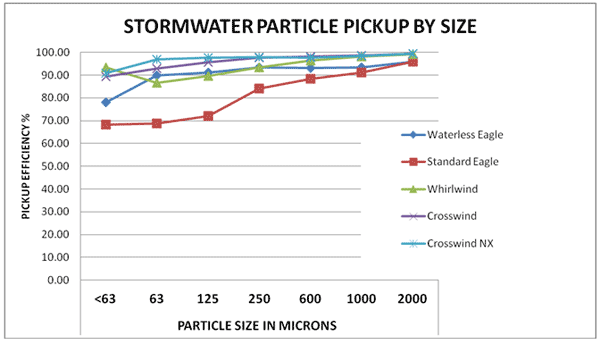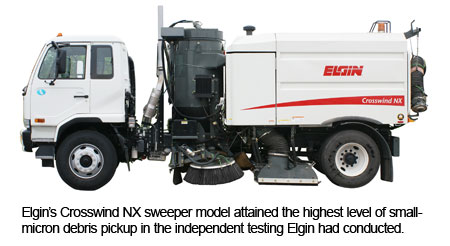Environmental Information for Sweeping Professionals |
Are U.S. Stormwater Managers Aware of the Effectiveness and Cost Benefits of Street Sweeping?
by Ranger Kidwell-Ross
Abstract
This article provides an overview on the demonstrated pickup capability of today's street sweepers. In addition, it includes information provided by several APWA-Certified Stormwater Managers who were contacted during its writing. They were surveyed to see what type of training about the effectiveness of street sweeping had been included as part of their respective learning processes, whether to gain their CSM designation or elsewhere.At the end of the article is a link to a seven-page information overview on the capabilities of street sweepers created by the author.
In November of 2011 I received the following letter from Brian Giles, Sweeper Products Manager for Elgin Sweeper Company. The testing he refers to was an independent slate of tests conducted by Roger Sutherland, of AMEC, Inc. Sutherland designed his testing protocol to quantify the pickup efficiency of several of Elgin's sweeper models.
Here is the pertinent content of Giles' letter:
 Ranger, Ranger, I just wanted to drop you a note to give you some kudos on your open letter to the sweeper manufacturing community challenging us all to get involved with some type of testing like the Roger Sutherland-created stormwater runoff efficiency tests. It's my understanding that the local municipalities in California, some of which have undertaken sponsoring these tests themselves, have learned a great deal about their own sweeping programs and will be able to further reduce their stormwater runoff based on this testing. As you are aware, Elgin Sweeper has long been a proponent of this type of testing and had Roger Sutherland create similar tests for us years ago. At Elgin, we believe that this type of independent data helps both the public and private sector understand just how important sweeping programs are for the long term health and well being of everyone. Sincerely, Brian Giles |
 As shown by the graph of the Elgin Sweeper test results shown to the left, the 2008 testing by the Elgin Sweeper Company shows that several of Elgin's current street sweeper models – both mechanical broom and air-based models – are much more effective in their pickup capabilities than was indicated in previous testing. Especially when it comes to Elgin's vacuum and regenerative air sweepers, this pickup ability was documented to include the ability to handle the majority of small-micron materials under 250 microns.
As shown by the graph of the Elgin Sweeper test results shown to the left, the 2008 testing by the Elgin Sweeper Company shows that several of Elgin's current street sweeper models – both mechanical broom and air-based models – are much more effective in their pickup capabilities than was indicated in previous testing. Especially when it comes to Elgin's vacuum and regenerative air sweepers, this pickup ability was documented to include the ability to handle the majority of small-micron materials under 250 microns.
As the graph indicates, even the mechanical broom Elgin Eagle using standard water-based dust suppression had a pickup capability in excess of 80% for material 250 microns and larger. (For reference, human hair is about 72 microns wide, so 250 microns is a little more than three times that width. The EPA targets waterborne pollutants as small as 10-microns; airborne pollutants as small as 2.5-microns.) The top small-micron pickup sweeper tested, Elgin's Crosswind NX, showed an ability to remove over 90% of material even smaller than a human hair.
And, as other analysis has shown, the expense of removing a pound of pollutants with an air sweeper – which the sweeper does in addition to the many pounds of larger, relatively unpolluted solids it removes as Total Suspended Solids (TSS) during operation – is only about $2 to $5/lb. By contrast, a study of structural BMPs by Caltrans indicates the cost per pound of pollutant removed as TSS runs $10 to $60/lb., not including land costs.
The same studies indicate that newer mechanical broom sweepers reduce TSS in stormwater at a cost of only $5 to $10 per pound. Plus, about half of the metals targeted by the EPA for removal are water soluble. Only by picking them up prior to runoff can they be removed effectively from the runoff stream.
This question arises, though: "Are stormwater runoff pollution managers in the U.S. and elsewhere generally aware of that these types of capabilities exist for street sweepers, as has been quantified in the Elgin testing?" So, as a second part to this article I contacted several individuals who had recently gained the coveted Certified Stormwater Manager (CSM) designation through the American Public Works Association. In addition, I spoke to William E. Spearman, P.E., Vice President at Woolpert in Columbia, South Carolina, who is the APWA's CSM certification expert and trainer.
 Although not a CSM himself, Spearman conducts a two-day class for individuals wanting to attain the CSM designation. "The goals required of stormwater managers vary somewhat widely in different parts of the U.S.," said Spearman, "due to weather conditions and the areas targeted pollutants. My intent in training is not to emphasize any particular best management practices (BMPs) over any others. Rather, I try to provide an overview of available BMPs so that the attendees will be able to form their own assessments given the particular needs and regulations unique to their area of the country."
Although not a CSM himself, Spearman conducts a two-day class for individuals wanting to attain the CSM designation. "The goals required of stormwater managers vary somewhat widely in different parts of the U.S.," said Spearman, "due to weather conditions and the areas targeted pollutants. My intent in training is not to emphasize any particular best management practices (BMPs) over any others. Rather, I try to provide an overview of available BMPs so that the attendees will be able to form their own assessments given the particular needs and regulations unique to their area of the country."
 John Reeves is a stormwater management professional with the City of St. Charles, Missouri. Reeves began by saying that his prior professional training had not included much information, if any, about the environmental benefits of street sweeping. As far as he was aware before our conversation, the primary goal of sweeping would be to get rid of solids on the street. Reeves was generally unaware of any particular value that sweeping had in terms of small particle removal. Rather, Reeves said, he primarily viewed sweepers as a way to get up larger solids and leaves, especially "to address the biomass and decay problems those create as it relates to stormwater. ...I see that as the primary goal of sweeping.
John Reeves is a stormwater management professional with the City of St. Charles, Missouri. Reeves began by saying that his prior professional training had not included much information, if any, about the environmental benefits of street sweeping. As far as he was aware before our conversation, the primary goal of sweeping would be to get rid of solids on the street. Reeves was generally unaware of any particular value that sweeping had in terms of small particle removal. Rather, Reeves said, he primarily viewed sweepers as a way to get up larger solids and leaves, especially "to address the biomass and decay problems those create as it relates to stormwater. ...I see that as the primary goal of sweeping.
"Secondarily," he continued, "is what the sweepings contain because of their exposure to petro-chemicals, etc., from the roadways. I am unaware that any data in that regard exists. [In terms of picking up smaller pollutants] ...the cost of removing runoff pollutants clearly increases as the particle sizes decrease. My opinion on stormwater issues is to take a wholistic approach, rather than an end-point treatment approach.
"We should do what we can to keep the leaves out of the street to begin with, through the city providing pickup and residents being made aware not to blow them out into the street. I believe in getting the stakeholders and the public to behave in a manner that minimizes stormwater runoff. It just makes sense to identify and take all the steps that can be identified along the way. I currently see street sweeping as one of those steps."
 Jonathan Wilson is a stormwater professional with the City of Eugene, Oregon. "The current focus of my work," Wilson related, "is industrial stormwater management. Street sweepers play a significant role in pollutant removal in that arena, especially considering how easily heavy metals and other pollutants bond with the solids generally removed by sweepers. Given the diversity of industrial site conditions, I don't believe that there is a one size fits all approach that can be used to determine the necessary sweeping frequency for pollutant removal.
Jonathan Wilson is a stormwater professional with the City of Eugene, Oregon. "The current focus of my work," Wilson related, "is industrial stormwater management. Street sweepers play a significant role in pollutant removal in that arena, especially considering how easily heavy metals and other pollutants bond with the solids generally removed by sweepers. Given the diversity of industrial site conditions, I don't believe that there is a one size fits all approach that can be used to determine the necessary sweeping frequency for pollutant removal.
"I have found the sweepers with suction/vactor capabilities that also utilize a low volume, fine mist to be the most effective in most situations. State and municipal regulations in Oregon prohibit the usage of sweepers that leave behind a volume of water that could produce visible runoff; i.e., washing pollutants off the road and into the storm system."
 Dan Clinton is a stormwater manager with Town of Cary, North Carolina. "I see sweeping as a viable best management practice," said Clinton. "I think in the future it will be one that... will qualify for regulatory credit by the State of North Carolina DNR. Sweeping appears to be a good way to reduce impacts: sediment, chemical and organic."
Dan Clinton is a stormwater manager with Town of Cary, North Carolina. "I see sweeping as a viable best management practice," said Clinton. "I think in the future it will be one that... will qualify for regulatory credit by the State of North Carolina DNR. Sweeping appears to be a good way to reduce impacts: sediment, chemical and organic."
However, when asked about his knowledge of the pluses and minuses of the two major types of sweeping technology, mechanical broom and air sweepers, he admitted that he had not received training related to street sweepers. Although he did not believe the North Carolina Department of Environment and Natural Resources (DENR) currently allowed regulatory credits for sweepers, street sweepers will be examined as an alternative BMP in the stormwater master plan the Town is currently preparing.
"Especially when we look closer at doing retrofits to improve water quality in existing watersheds," Clinton went on to say, "I think we'll be taking a closer look at where sweeping might fit in. Part of the overall plan, especially in areas where the complexity of retrofitting makes it very difficult to meet established goals, there will likely be a greater emphasis on street sweeping for pollutant removal."
Although I tried not to preconceive the responses I would get from the newly minted APWA Certified Stormwater Managers I might speak with, the results were as might be expected. Based on calls from stormwater managers I receive throughout the year, as well as other contacts with them I have had, U.S. stormwater managers appear to be, for the most part, relatively unaware of the high pickup percentage that it appears current sweeping technology can provide.
WorldSweeper has long encouraged the formation of a 'sweeper manufacturers consortium,' whose goals would include providing the latest data on the environmental benefits of sweeping to stormwater professionals and others throughout the U.S. As you can learn in the linked PDF file, the WorldSweeper.com-developed "Historical and Current Overview on Characteristics and Capabilities of Street-Class Power Sweepers," for a variety of reasons today's sweepers appear capable of playing a larger role in reducing pollutants flowing to America's water resources.
Only through such education will stormwater managers realize that by shifting resources toward additional sweeping – done by the type of sweeper best suited for the desired results, operated by a trained professional at the correct speed – will they be able to attain superior TSS removal results at lower overall cost. However, until this information is widely dispersed and available to stormwater decisionmakers, they will continue to recommend the increasingly expensive infrastructure retrofits, increased catchbasin filtration and other solutions at the end of the runoff stream.
The author, Ranger Kidwell-Ross, MA, is a graduate economist and the world's most prolific author of articles and information on power sweeping. He was the founder of American Sweeper magazine, and in 2005 founded and has remained Editor of WorldSweeper.com. You may reach him via email sent to editor@worldsweeper.com or by calling (866) 635-2205.